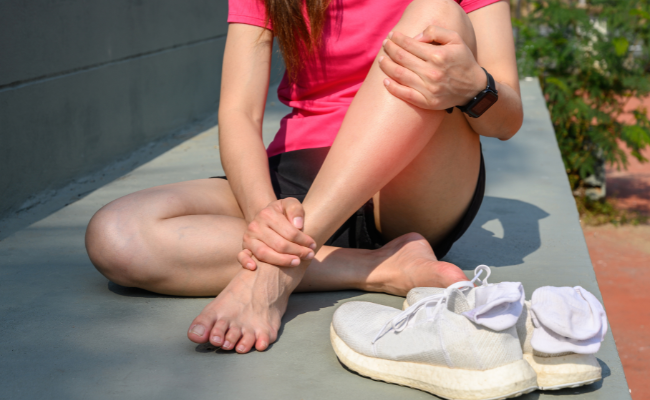How to Treat Shin Splints?
- December 21, 2023
- No Comments

What is Shin Splints?
Shin splints, or medial tibial stress syndrome, is a prevalent condition marked by pain along the tibia, commonly affecting athletes engaged in activities like running or jumping. The discomfort arises from inflammation in the muscles and tissues surrounding the shinbone. Treatment typically involves rest and ice application, helping many individuals recover without long-term complications.Referred to by healthcare professionals as medial tibial stress syndrome, shin splints highlight the stress-induced nature of the condition. While rest and ice are effective for recovery, neglecting treatment may lead to the progression of shin splints into a more severe tibial stress fracture.
Why Do Shin Splints Occur?
Shin splints occur due to excessive stress on the shinbone and the tissues attaching the shinbone to the muscles surrounding it. Several factors contribute to the development of shin splints, including overpronation or underpronation of the foot, inadequate footwear, running on hard surfaces, sudden changes in physical activity, and muscle imbalances. These factors lead to increased strain on the muscles and tendons, resulting in inflammation and pain.
How to Identify Shin Splints?
- Identifying shin splints involves recognizing the characteristic symptoms associated with the condition. Individuals with shin splints often experience pain along the inner edge of the shinbone, tenderness, and swelling. The pain is usually dull and aching but may progress to a more intense throbbing sensation during physical activity. In severe cases, individuals may also notice lumps or bumps along the shinbone.
- To confirm a diagnosis of shin splints, healthcare professionals may perform a physical examination, evaluate the medical history of the individual, and sometimes recommend imaging tests such as X-rays or MRI scans to rule out other potential causes of the symptoms.
Treatment Solutions for Shin Splints
- Rest and Activity Modification: The primary step in treating shin splints involves giving the affected leg adequate rest. This means avoiding activities that exacerbate the pain, such as running or jumping. Individuals may need to modify their training routine and incorporate low-impact activities like swimming or cycling to maintain cardiovascular fitness without putting excessive stress on the shinbone.
- Ice Therapy: Applying ice to the affected area can help reduce inflammation and alleviate pain. Ice packs or cold compresses should be applied for 15-20 minutes every 2-3 hours during the initial stages of shin splints.
- Compression: Wearing compression sleeves or wraps around the affected shin can provide support and reduce swelling. Compression helps improve blood circulation and minimizes the strain on the injured tissues.
- Elevating the Leg: Elevating the leg when at rest can aid in reducing swelling. Keeping the leg elevated, especially during sleep, helps to prevent the accumulation of fluid in the affected area.
- Footwear and Orthotics: Choosing appropriate footwear is crucial in preventing and treating shin splints. Supportive shoes with proper arch support and cushioning can help distribute the impact of physical activity more evenly. In some cases, orthotic inserts may be recommended to correct foot mechanics and reduce stress on the shinbone.
- Stretching and Strengthening Exercises: Incorporating stretching exercises for the calf muscles and Achilles tendon can help improve flexibility and reduce tension on the shinbone. Strengthening exercises for the muscles in the lower leg, particularly the ones responsible for dorsiflexion, can enhance stability and reduce the risk of shin splints.
- Gradual Return to Activity: After a period of rest and symptom relief, individuals can gradually return to their regular activities. It is essential to start with low-impact exercises and gradually increase intensity to allow the shinbone and surrounding tissues to adapt without causing a recurrence of symptoms.
Benefits of Shin Splint Treatment
- Pain Relief: Effective treatment strategies provide relief from the persistent pain associated with shin splints, allowing individuals to resume their normal activities without discomfort.
- Prevention of Complications: Prompt and appropriate treatment helps prevent the progression of shin splints to more severe conditions, such as stress fractures or chronic inflammation, which could lead to prolonged recovery periods.
- Improved Performance: By addressing the underlying causes of shin splints and incorporating preventive measures, individuals can enhance their overall athletic performance and reduce the risk of future injuries.
- Enhanced Mobility: Treatment solutions that include stretching and strengthening exercises contribute to improved flexibility and strength, enhancing the overall mobility of the affected leg.
- Long-Term Well-being: Managing shin splints effectively promotes long-term musculoskeletal health, reducing the likelihood of recurrent injuries and ensuring the well-being of individuals engaged in physical activities.
Comments (0)